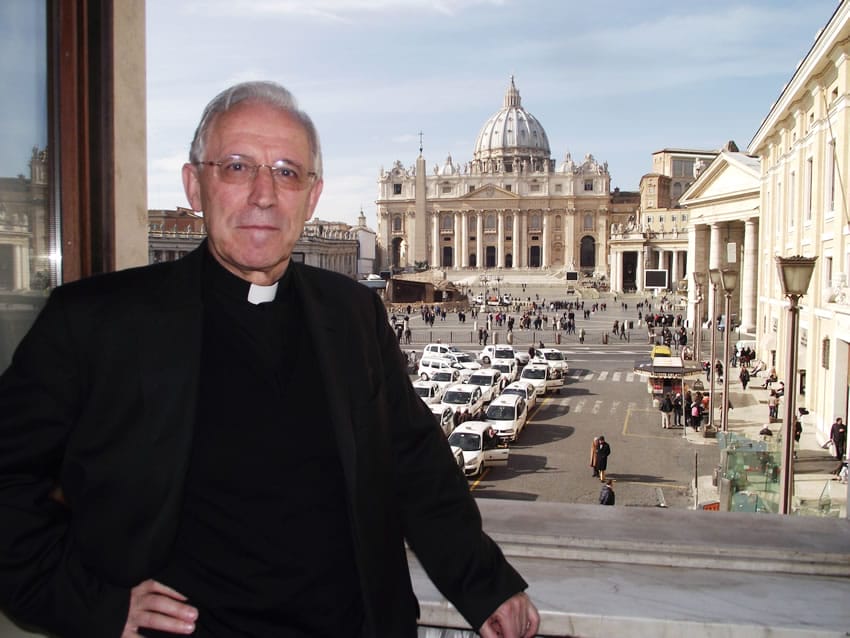In the first years of the recollection there were two convents of friars in the diocese: one in Borja, founded in 1602 and four years later, in 1606, the one in Catalayud. For more than three hundred years, until 1835 when all monasteries in Spain were closed, the Recollects were indeed a spiritual force in the diocese of Tarazona. The enclosed Augustinian Recollect nuns, in the convent of the Incarnation in Agreda, at the other end of the diocese was another important presence. The nuns were there from 1660 till 2007.


Santiago Matute. In 1824 the idea of founding a seminary to prepare Recollect missionaries for the Philippines took root and the town of Alfaro ( Rioja) in the north east of the diocese was picked. Five years later, in 1829 the seminary moved to Monteagudo, Navarra, seven kilometres from Tarazona. From 1829-1877 Monteagudo was the only convent for male religious in the diocese and right from the start there was a great sense of cooperation and good will between the superiors and the bishops.
Bishop Castillón Salas (1815-1835) was in favour of the founding of the convent. His successor, the domincan Vicente Ortiz Labastida (1848-1852), would retreat there every year in search of peace and tranquility. He enjoyed conversing with the friars and on Fridays he loved to hear the reading of the Rule of St. Augustine, in the dining room. During the long years of Bishop Cosme Marrodán’s leadership (1857-1888) the relationship went even deeper. The prelate often visited the monastery where he found peace, shared similar ideas and a confessor to care for his soul.
When St. Ezequiel Moreno (1885-1888) was superior there was total harmony. When he was dying the bishop wanted Fr. Ezequiel at his bedside. He visited him a number of times, even in the small hours of the morning and was with him when he gave his last breath. During the long process of St. Ezequiel’s canonization more evidence of the meetings came to light. The diocese participated very actively in those ordinary and apostolic processes.
A seedbed for Recollects
Until these last decades the Order had always counted hundreds of religious born in this diocese among its members. A large part of these came from the area around Borja known as “the campo de Borja” and also from the arch-deanery of Catalayud. In the middle of the 18th century the numbers of those born in Tarazona and surrounding towns grew and occupied first place. Between 1738 and 1897 there were as many as 80 born in the city itself. Among these we can count a good number of eminent religious whose influence was felt inside and outside the Order.


Ramón Zueco. Fr. Miguel de Jesus Maria (†1781), best known by the name “Moncayo”, was twice Provincial of Aragón and then Vicar General (1772-1778), the highest authority of the Recollects at that time. Manuel Carasusan (1811-1859), the first citizen from Tarazona to make his profession in Monteagudo (1829), was in charge of the Province of the Philippines from 1855 to 1858.
Ramón Zueco (1828-1889) who, for years, went around the small settlements of Mindanao, offered his services to the Spanish government during the campaign for Joló (1876). He also published a dozen books on religious and linguistic themes. For ten years (1899-1909), Bernardino García (1862-1937) was one of the most influential religious in Panamá. During the war that preceded the nation’s independence (1899-1902) he organized a hospital for blood that was used by both sides in the conflict.
On the 15 of May 1903 he attended General Victoriano Lorenzo, a national hero, as he was dying, and on the 20 December that same year he blessed the flag of the new republic. He also helped in the starting up of the La Defensa Social newspaper and was the national inspector of schools. Santiago Matute (1857-1919) as a young friar, taught philosophy in Monteagudo. From 1889 to 1894 he worked with St. Ezequiel in restoring the Recollection in Colombia and afterwards he would take that task on board.


El 28 de mayo se cumplieron los cincuenta años de su ordenación sacerdotal. The Blessed José Rada (1861-1936), was also from Tarazona and was a missionary in the Philippines and Brazil. He was martyred during the Spanish civil war.
The last two Recollects from the city of Tarazona were Jorge Hernández (1868-1940) and Félix Coscolín (1878-1940). The first one made his profession in 1895 and the second in 1897. From 1897 till 1906 the novitiate house of Monteagudo was closed on account of the Filipino revolution. When it started up again in 1906 you could count on one hand those from Tarazona who came knocking at the door. Out of those few no one reached profession.
The pastoral work Fr. Eusebio Hernández will lead in the diocese of Tarazona will find an echo in this fertile and prolonged relationship which showed itself most proficient in the numerous religious who came from those places that belonged and belong to the diocese of Tarazona.


